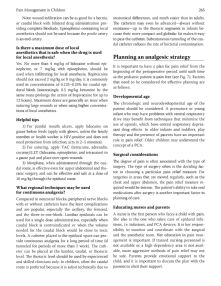Page 277 Guide to Pain Management in Low-Resource Settings
P. 277
Pain Management in Children 265
Note: wound infi ltration can be as good for a hernia, anatomical diff erences, and much easier than in adults.
or caudal block with bilateral drug administration pro- Th e catheters may even be advanced—always without
viding complete blockade. Epinephrine-containing local resistance—up to the thoracic segments in infants be-
anesthetics should not be used because the penile artery cause their more compact and globular fat makes it easy
is an end-artery. to pass the catheter. Subcutaneous tunneling of the cau-
dal catheter reduces the rate of bacterial contamination.
Is there a maximum dose of local
anesthetics that is safe when the drug is used
for local anesthesia? Planning an analgesic strategy
Yes. No more than 4 mg/kg of lidocaine without epi-
It is important to have a plan for pain relief from the
nephrine, or 7 mg/kg with epinephrine, should be
beginning of the perioperative period until such time
used when infi ltrating for local anesthesia. Bupivacaine
as the pediatric patient is pain free (see Fig. 7). Factors
should not exceed 2 mg/kg or 8 mg/day; it is commonly
that need to be considered for eff ective planning are
used in concentrations of 0.125–0.25% for caudal epi-
as follows.
dural block (interestingly, 0.5 mg/kg ketamine by the
same route prolongs the action of bupivacaine for up to Developmental age
12 hours). Maximum doses are generally an issue when
Th e chronologic and neurodevelopmental age of the
suturing large wounds or when using higher concentra-
patient should be considered. A premature or young
tions of local anesthetics.
infant who may have problems with central respiratory
Helpful tips drive may benefi t from techniques that minimize the
use of opioids, which have central respiratory depres-
1) For painful mouth ulcers, apply lidocaine on
sant drug eff ects. In older infants and toddlers, play
gauze before feeds (apply with gloves, unless the family
therapy and the presence of parents have an important
member or health worker is HIV-positive and does not
role in pain relief. Older children may understand the
need protection from infection; acts in 2–5 minutes).
concept of a PCA.
2) For suturing, apply TAC (tetracaine, adrenalin,
cocaine)/LET (lidocaine, epinephrine, and tetracaine) to
Surgical considerations
a gauze pad and place over open wounds.
Th e degree of pain is often associated with the type of
3) Morphine, when administered through the cau-
dal route, is eff ective even for upper abdominal and tho- surgery. Th e type of surgery often is the deciding fac-
tor in choosing a particular pain relief measure. For
racic surgery, and can be eff ective and safe at a dose of
10 mg/kg through the epidural route. surgeries in areas that are moved regularly, such as the
chest and upper abdomen, the pain relief measure re-
What regional techniques may be used quired would be intense. Th e patient’s ability to take oral
for continuous analgesia? medications after surgery is another important factor in
Compared to neuraxial blocks, peripheral nerve blocks planning of care.
with or without catheters have the least complications
Educating nurses and parents
and are popular, especially the axillary, the femoral,
and the three-in-one-block. Lumbar epidurals can be A nurse is the fi rst person who faces a child with pain.
used for a single dose administration, especially when She also is the one who takes care of epidural infu-
caudal block is contraindicated or when the volume sions, i.v. infusions, and PCA devices. It is her respon-
needed for the caudal block would be close to toxic sibility to monitor and coordinate with the surgical
levels. A catheter placed in the epidural space can pro- and the anesthetic team. Her education in pain man-
vide continuous analgesia for a long period of time (if agement is important. If trained nursing personnel is
tunneled for periods of more than 1 week). Th e cath- not available or a high-dependency area is not avail-
eter can be placed at the lumbar, caudal, or thoracic able, more aggressive methods of pain relief may not
level. Th e thoracic level should be used by experienced be safe. Parents provide emotional support to the
and skilled clinicians only. In children, often the caudal child, and it is important to discuss the plan with the
route is preferred because it is safest technically due to parents to elicit their support.


